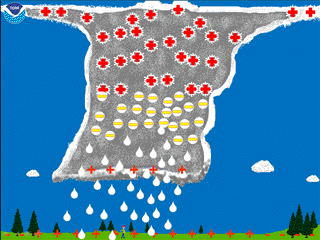Lightning is fascinating to watch but also extremely dangerous. In the United States, there are about 25 million lightning flashes every year. Each of those 25 million flashes is a potential killer. While lightning fatalities have decreased over the past 30 years, lightning continues to be one of the top weather killers in the United States. In addition, lightning injures many more people than it kills and leaves some victims with life-long health problems.
Understanding the dangers of lightning is important so that you can get to a safe place when thunderstorms threaten. If you hear thunder—even a distant rumble—you are already in danger of becoming a lightning victim.
All thunderstorms go through stages of growth, development, electrification and dissipation. Thunderstorms often begin to develop early in the day when the sun heats the air near the ground and pockets of warmer air start to rise in the atmosphere. When these pockets of air reach a certain level in the atmosphere, cumulus clouds start to form. Continued heating causes these clouds to grow vertically into the atmosphere. These "towering cumulus" clouds may be one of the first signs of a developing thunderstorm. The final stage of development occurs as the top of the cloud becomes anvil-shaped.
As a thunderstorm cloud grows, precipitation forms within the cloud. A well-developed thunderstorm cloud contains mostly small ice crystals in the upper levels of the cloud, a mixture of small ice crystals and small hail in the middle levels of the cloud, and a mixture of rain and melting hail in the lower levels of the cloud. Air movements and collisions between the various types of precipitation in the middle of the cloud cause the precipitation particles to become charged. The lighter ice crystals become positively charged and are carried upward into the upper part of the storm by rising air.
The heavier hail becomes negatively charged and is either suspended by the rising air or falls toward the lower part of the storm. These collisions and air movements cause the top of the thunderstorm cloud to become positively charged and the middle and lower part of the storm to become negatively charged.
In addition, a small positive charge develops near the bottom of the thunderstorm cloud. The negative charge in the middle of thunderstorm cloud causes the ground underneath to become positively charged, and the positively charged anvil causes the ground under the anvil to become negatively charged.
Lightning is a giant spark of electricity in the atmosphere or between the atmosphere and the ground. In the initial stages of development, air acts as an insulator between the positive and negative charges in the cloud and between the cloud and the ground; however, when the differences in charges becomes too great, this insulating capacity of the air breaks down and there is a rapid discharge of electricity that we know as lightning.
Lightning can occur between opposite charges within the thunderstorm cloud (Intra Cloud Lightning) or between opposite charges in the cloud and on the ground (Cloud-To-Ground Lightning). Cloud-to-ground lightning is divided into two different types of flashes depending on the charge in the cloud where the lightning originates.
Thunder is the sound made by a flash of lightning. As lightning passes through the air it heats the air quickly. This causes the air to expand rapidly and creates the sound wave we hear as thunder. Normally, you can hear thunder about 10 miles from a lightning strike. Since lightning can strike outward 10 miles from a thunderstorm, if you hear thunder, you are likely within striking distance from the storm.
Learn More: Thunderstorm Development or return to Contents page
How Hot is Lightning?




The sound of thunder travels about a mile every
5 seconds. If you count the seconds between the flash of lightning and the crack of thunder and divided by 5, you get the number of miles away from you
(10 seconds is 2 miles).